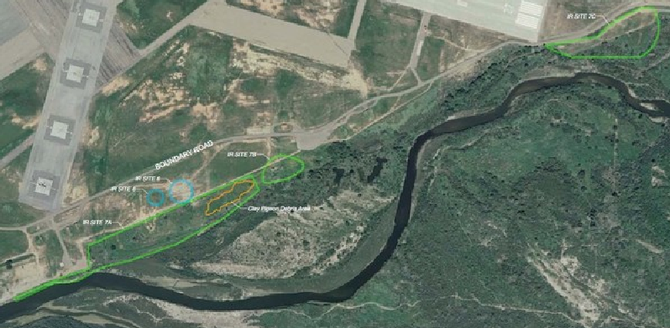 Facebook
Facebook
 X
X
 Instagram
Instagram
 TikTok
TikTok
 Youtube
Youtube

Tons of contaminated soil will be excavated from two sites at the southern border of Naval Outlying Landing Field (NOLF) Imperial Beach within the next month, according to Michael Pound of Naval Facilities Engineering Command Southwest.
The former naval air station was considered the “Helicopter Capital of the World” during the Vietnam War, until a majority of the air operations were moved to Naval Air Station North Island in 1975.
According to Pound, studies compiled by contractors for the Navy found substances in the area that could pose a risk to the health of local wildlife, such as deer mice and burrowing owls or Navy personnel who need to drive by or mow the weeds.
During the late 1940s until the late 1960s, construction debris, sandblast grits, creosote pilings, and oiled soils were used for bluff stabilization, and a skeet-shooting range operated that used clay pigeons filled with black tar. All those contaminants have infiltrated the soil.
Up until the late 1980s, another area was used for firefighting: aircraft hulls and other materials were burned in large pits using large volumes of combustible fluids, including fuels and solvents.
The five-million-dollar project funded by the federal government’s Comprehensive Environmental Response, Compensation, and Liability Act (CERCLA) — commonly known as "Superfund” — will remove approximately 5000 cubic yards of soil, which will be loaded onto trucks outfitted with one-piece liners and then covered with tarps. Contractors on the job site will monitor the air and employ dust-mitigation techniques.
According to Pound, the City of Imperial Beach has requested that trucks coming to and leaving the city use 13th Street and Imperial Beach Boulevard to avoid a major pedestrian crossing at Central Elementary School 13th and Ebony Avenue.
When informed that Imperial Beach Boulevard would take the trucks past two elementary schools, a middle school, and the popular Wednesday swap meet at the South Bay Drive-in, Pound said they would ask the city for some clarification.


Tons of contaminated soil will be excavated from two sites at the southern border of Naval Outlying Landing Field (NOLF) Imperial Beach within the next month, according to Michael Pound of Naval Facilities Engineering Command Southwest.
The former naval air station was considered the “Helicopter Capital of the World” during the Vietnam War, until a majority of the air operations were moved to Naval Air Station North Island in 1975.
According to Pound, studies compiled by contractors for the Navy found substances in the area that could pose a risk to the health of local wildlife, such as deer mice and burrowing owls or Navy personnel who need to drive by or mow the weeds.
During the late 1940s until the late 1960s, construction debris, sandblast grits, creosote pilings, and oiled soils were used for bluff stabilization, and a skeet-shooting range operated that used clay pigeons filled with black tar. All those contaminants have infiltrated the soil.
Up until the late 1980s, another area was used for firefighting: aircraft hulls and other materials were burned in large pits using large volumes of combustible fluids, including fuels and solvents.
The five-million-dollar project funded by the federal government’s Comprehensive Environmental Response, Compensation, and Liability Act (CERCLA) — commonly known as "Superfund” — will remove approximately 5000 cubic yards of soil, which will be loaded onto trucks outfitted with one-piece liners and then covered with tarps. Contractors on the job site will monitor the air and employ dust-mitigation techniques.
According to Pound, the City of Imperial Beach has requested that trucks coming to and leaving the city use 13th Street and Imperial Beach Boulevard to avoid a major pedestrian crossing at Central Elementary School 13th and Ebony Avenue.
When informed that Imperial Beach Boulevard would take the trucks past two elementary schools, a middle school, and the popular Wednesday swap meet at the South Bay Drive-in, Pound said they would ask the city for some clarification.
Comments